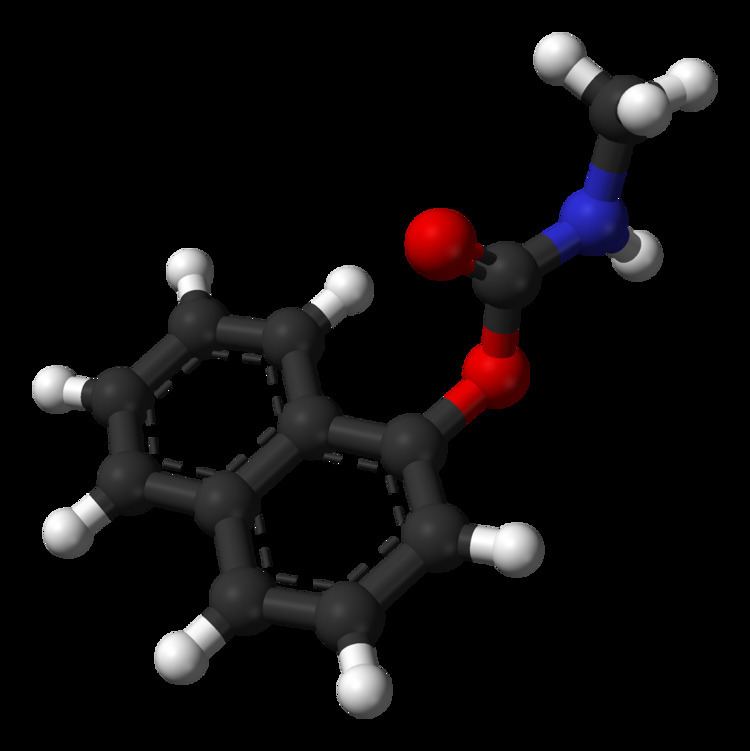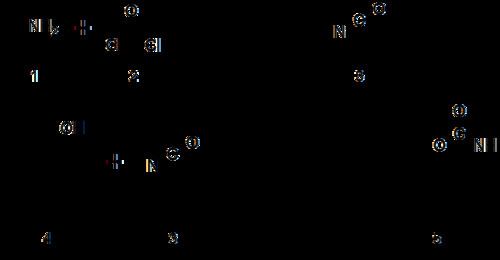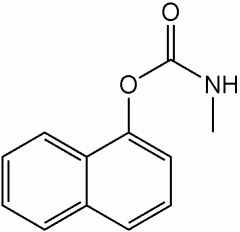Formula C12H11NO2 Melting point 142 °C Soluble in Water | Molar mass 201.22 g/mol Density 1.2 g/cm³ | |
 | ||
Appearance Colorless crystalline solid IUPAC ID 1-naphthyl methylcarbamate | ||
Carbaryl (1-naphthyl methylcarbamate) is a chemical in the carbamate family used chiefly as an insecticide. It is a white crystalline solid commonly sold under the brand name Sevin, a trademark of the Bayer Company. Union Carbide discovered carbaryl and introduced it commercially in 1958. Bayer purchased Aventis CropScience in 2002, a company that included Union Carbide pesticide operations. It remains the third-most-used insecticide in the United States for home gardens, commercial agriculture, and forestry and rangeland protection. About 11 million kilograms were applied to U.S. farm crops in 1976. As a veterinary drug, it is known as carbaril (INN).
Contents

Production
Carbaryl is produced by treating methyl isocyanate (3) with 1-naphthol (4).

Alternatively, 1-naphthol (1) is reacted with phosgene (2) to synthesize its chloroformate (3), which is then treated with methylamine to give the desired product (4):

The former process was carried out in Bhopal. In comparison, the latter synthesis uses exactly the same reagents, but in a different sequence. This synthesis avoids the preparation of methyl isocyanate, and the comparison is often used as a case study in green chemistry. However, the second synthesis still uses phosgene, which is toxic and reacts with water, and methylamine, which is a toxic and flammable gas.
Biochemistry
Carbamate insecticides are slowly reversible inhibitors of the enzyme acetylcholinesterase. They resemble acetylcholine, but the carbamoylated enzyme undergoes the final hydrolysis step very slowly (minutes) compared with the acetylated enzyme generated by acetylcholine (microseconds). They interfere with the cholinergic nervous system and cause death because the effects of the neurotransmitter acetylcholine cannot be terminated by carbamoylated acetylcholinesterase.
Applications
The development of the carbamate insecticides has been called a major breakthrough in pesticides. The carbamates do not have the persistence of chlorinated pesticides. Although toxic to insects, carbaryl is detoxified and eliminated rapidly in vertebrates. It is neither concentrated in fat nor secreted in milk, so is favored for food crops, at least in the US. It is the active ingredient in Carylderm shampoo used to combat head lice until infestation is eliminated.
Risk
Carbaryl kills both targeted (e.g. malaria-carrying mosquitos) and beneficial insects (e.g. honeybees), as well as crustaceans.

Although approved for more than 100 crops in the US, carbaryl is illegal in several countries, including the United Kingdom, Austria, Denmark, Sweden, Iran, Germany, and Angola.
Carbaryl is often produced using methyl isocyanate (MIC) as an intermediary. A leak of MIC used in the production of carbaryl caused the Bhopal disaster, the largest industrial accident in history.
Safety
Carbaryl is a cholinesterase inhibitor and is toxic to humans. It is classified as a likely human carcinogen by the United States Environmental Protection Agency (EPA.) The oral LD50 is 250 to 850 mg/kg for rats and 100 to 650 mg/kg for mice.
